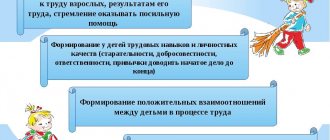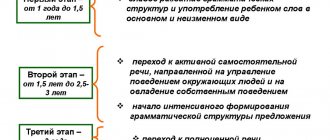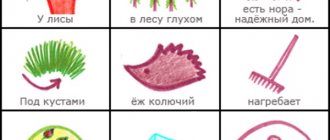MAGAZINE Preschooler.RF
“Finger gymnastics as a means of speech development for preschool children”Bolotova Natalya Viktorovna Teacher-speech therapist of the highest qualification category MBDOU "Kindergarten of compensatory type No. 17" Sergiev Posad municipal district Moscow region, Sergiev Posad,
annotation
This article examines the relevance and usefulness of finger games as a means of speech development during correctional and educational work in preschool institutions. The purpose, tasks of finger gymnastics, and the rules for its implementation are described. Examples of finger games for classes with children, “tied” to the study of lexical topics for the 1st period of study (September-November) are given.
Topic: “Finger gymnastics as a means of speech development for preschool children”
The popularity of finger games has increased significantly. Such games are not a newfangled hobby for modern parents. They have existed among different peoples since ancient times. And no wonder, because finger games are a wonderful way to cheer up a child, distract him from something, and find contact with any child.
The development of the motor side of speech depends not only on the functional capabilities of the facial-articulatory muscles directly involved in the implementation of speech acts; The development of a child’s speech is also indirectly related to the state of his general motor skills, i.e. motor activity in general.
Previously, it was believed that the main thing on which speech development depends is the degree of verbal communication between children and surrounding adults. However, research by scientists has shown that the degree of verbal communication with adults does not play as big a role as expected. They also studied the relationship between a child's speech ability and his motor functions. Studying the anatomical relationships of the child’s body, scientists, neuropathologists and defectologists came to the conclusion that the child’s speech ability depends not only on the training of the articular apparatus, but also on the movements of the fingers. The hand can be classified as a speech apparatus, and the motor projection area of the hand can be classified as
How to do finger gymnastics?
Babies can perform finger exercises directly after about a year. From this time you can start classes. To make them interesting, usually each game is accompanied by a certain rhythmic text - poems, nursery rhymes, fairy tales, which are “dramatized” with the help of fingers and palms. An adult must pronounce the words of the game rhythmically and expressively. This helps the child learn to formulate his speech correctly and beautifully. Children's imagination is actively involved in the game, and they do the exercises with pleasure.
The basic rules for such activities are as follows.
- An adult’s hands should not be cold (after all, games involve both demonstration of movements, as well as their correction and mutual participation).
- Before starting gymnastics, you need to do a general warm-up for your hands and fingers so that they warm up and become more pliable (just as it is important for an athlete to stretch the necessary muscles before a performance or match).
- During games, it is important to ensure that the child uses all fingers in the exercises.
- When carrying out such gymnastics, parents should not only monitor how the child performs the exercises, but also exert a tactile influence on the baby’s hands (stroking, tickling).
- Games should not be held in a forced manner, otherwise they will do more harm than good.
- The key to success is systematic training.
Advice
For children who can already make choices and have preferences, you can create a card index of games. Teach your child to look at the pictures on the cards so he can choose which exercises he wants to do that day. Follow his choice for several days. Try to somehow change those exercises that he systematically rejects: choose a more lively text, add emotions, change the picture on the card, dilute the game, for example, with rhythmic musical accompaniment.
If a child under 3 years of age has lost interest in finger gymnastics in an “ideal” form, you can switch him to another type of exercise - playing with objects:
- rolling round objects (plastic balls, balls, small fruits) across the table or floor;
- sorting cereals or small construction parts;
- pyramid assembly;
- building a tower from cubes;
- putting together a mosaic;
- painting with fingers (on flour, sand, cereals, scattered in a thin layer);
- examination by touch of materials with different textures (silk, fur, polyethylene, wood, metal, feathers, plastic, terry or woolen items, etc.).
From about 2 years old, you can transfer finger games with children to paper. You can roll it into balls or roll it into thin paper strips. Fingers work great if you ask the child to tear small pieces from a whole sheet. Let the child put the resulting scraps into a small glass.
Passive gymnastics (massage)
It is better if an experienced professional shows you the massage technique, but you can master the simplest techniques yourself.
The massage is performed with one hand, the other holds the massaged hand. Session duration: 3 – 5 minutes; carried out several times a day.
Massage includes the following types of movements:
- Stroking - performed in different directions;
- Rubbing - differs from stroking with a greater force of pressure (the hand does not slide over the skin, but moves it);
- Vibration - applying frequent blows with the tips of half-bent fingers;
- Massage using a special ball - with the ball you need to make movements in a spiral from the center of the palm to the tips of the fingers; practical advice: you need to use a hard ball, that is, it should not be easily deformed (then the impact will be maximum);
- Flexion-extension of the fingers - the fingers are initially clenched into a fist, each in turn is extended and massaged from the side of the palm in a circular motion from the base to the tip.
We talk more about massage here.
Finger gymnastics as a means of developing speech and fine motor skills
Chapter 1. Theoretical foundations of the use of finger gymnastics as a means of developing speech and fine motor skills of the hands of a child of primary preschool age
1. 1 From the history of the emergence of educational technology of finger games
The priority for recognizing finger games as official pedagogy belongs to German specialists. Back in 1873, the outstanding German teacher Friedrich Froebel highlighted the educational significance of finger games and included them in the curriculum of the kindergartens he created. Froebel suggested that it was the association of the sound and meaning of words with the child's own body that best suited the learning style of young children. At that time, there could be no theoretical justification for this method; Froebel made conclusions based on his own observations and intuition.
Previously, there were many folk finger games, nursery rhymes that accompanied the childhood of our great-grandmothers and grandmothers, games that are now forgotten or half-forgotten. Over the last decade, experts have been searching for and reviving such games, turning to ethnographers, folklorists, philologists for help, using specialized literature, and conducting surveys in various regions of Russia. Many of the newfound games are not outdated and are naturally perceived by children. The child encountered folk finger games already in the cradle, or rather, on the lap of his mother, grandmother, or nanny. These were not games yet, but nursery rhymes and nursery rhymes - fun between an adult and a child. Few people know that everyone’s favorite “Magpie-Crow”
doesn't end with the wiggling of the slacker little finger:
«You didn’t carry wood, you didn’t carry water.”
The game had a continuation.
The adult says: “Know in advance: The water here is cold”
(and stroked the child’s wrist).
“ It’s warm here”
(stroked it at the elbow);
“It’s hot in here”
(stroking it near the shoulder);
“And here it’s boiling water, boiling water!”
(tickled under the arm).
This fun game allows the child to feel the joy of physical contact, to feel his fingers, palm, elbow, shoulder; to realize oneself in the system of bodily coordinates, and ultimately to formulate a body diagram. This prevents the occurrence of many neuroses in the future and gives a person a sense of self-control. Similar games are found among many nations.
1.2The influence of finger games on a child’s development
Finger games develop a child's brain, stimulate speech development, creativity, and imagination. Simple movements help to remove tension not only from the hands themselves, but also to relax the muscles of the whole body. They can improve the pronunciation of many sounds. In general, the better the fingers and the entire hand work, the better the child speaks. Why is this so? Let's figure it out. The fact is that the hand has the largest “representation” in the cerebral cortex, therefore the development of the hand plays an important role in the formation of the brain and the formation of speech. And that is why the child’s verbal speech begins when the movements of his fingers achieve sufficient accuracy. The child’s hands, as it were, prepare the ground for the subsequent development of speech. In addition, the goal of classes to develop dexterity and accuracy of the fingers is to develop the relationship between the hemispheres of the brain and the synchronization of their work. In the right hemisphere of the brain we have various images of objects and phenomena, and in the left they are verbalized, that is, they find verbal expression, and this process occurs thanks to the “bridge” between the right and left hemispheres. The stronger this bridge, the faster and more often nerve impulses travel along it, the more active the thought processes, more precisely the attention, the higher the abilities. If you want your child to speak well, learn quickly and easily, and deftly perform even the most delicate work, start developing his hands: fingers and hands from an early age. Finger games have been common among a variety of peoples for a long time. In China, exercises with stone and metal balls are common. Regular exercises with them improve memory, activity of the cardiovascular and digestive systems, eliminate emotional stress, develop coordination of movements, strength and dexterity of the hands, and maintain vitality. And in Japan, exercises for palms and fingers with walnuts are widely used. Rolling a hexagonal pencil between your palms has an excellent effect. And from an early age we were taught to play “Ladushki”, “White-sided Magpie”, “Horned Goat”. Today, experts are reviving old games and inventing new ones. Finger games can be said to be an excellent universal, didactic and developmental material. The methodology and meaning of these games is that the nerve endings of the hands affect the child’s brain and brain activity is activated. For school learning, it is very important that the child has well-developed fine motor skills. Finger games are good helpers for preparing a child’s hand for writing and developing coordination. And in order for speech to develop at the same time, you can use small rhymes, counting rhymes, and songs for such games. In principle, teachers and parents themselves can “translate any poetic works of this kind onto their fingers,” i.e. come up with movements for the fingers that accompany speech - at first simple, uncomplicated, and then complicate these movements. Thanks to finger games, the child receives a variety of sensory impressions, he develops attentiveness and the ability to concentrate. Such games form good relationships between adults and children.







